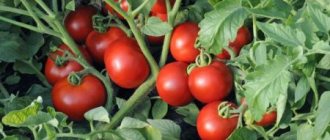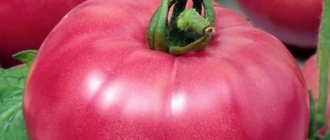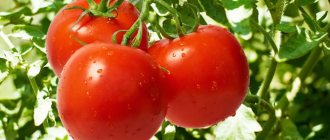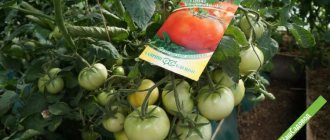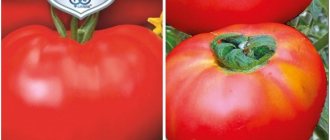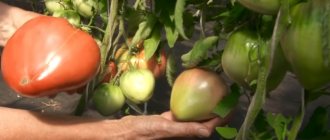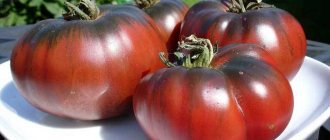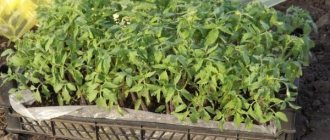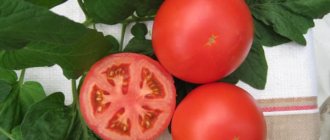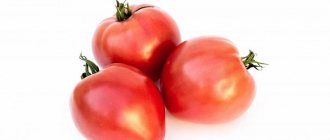Characteristics and description of the variety
Before growing a new variety, you need to know its basic characteristics. This will save you from annoying mistakes during breeding.
The main feature of the Mammoth variety is indicated by its name. It is famous for its large fruits weighing from 300 to 500 g. The tomatoes are sweet, pink and raspberry in color. But there are also unevenly colored tomatoes, the so-called “marbled”.
The fruits are semicircular, flattened, fleshy and starchy. There are few seeds in them and they are small. The cut may have white veins.
Ripe tomatoes are soft and distinctly ribbed. Due to their size they may crack.
The variety is early ripening, which is not typical for such large fruits. Used for food and for preparing fresh vegetable salads. Not suitable for preservation due to its size.
Bush characteristics:
- The bushes grow up to 2 m. To bring the shoot to such a height, it is necessary to grow them into two trunks.
- The leaves are dark green, medium to small in size. There are few of them, and the giant fruits on the bush are clearly visible.
- 4-5 clusters are formed on the bushes, 3-4 tomatoes are tied on each. The normal yield from one bush is 20 fruits. But what kind! The weight of the harvest from one bush can be about 10 kg.
- The average time from sowing to fruit ripening is 110-115 days. Can be grown both in a greenhouse and in open ground.
Variety Black Mammoth
There is a variety with similar characteristics - Black Mammoth . Belongs to the mid-season, medium-sized species. The fruits are fleshy, dense, and have a dark burgundy color when ripe. The weight of the fruit varies from 200 to 500 g. Large berries may crack.
The Black mammoth variety bush is formed into two or three stems. But to get giant fruits, farmers leave one stem. It is not recommended to use tomatoes for preparations or to preserve them in slices. Preferred use is fresh consumption in salads, making juices.
The rules of agricultural technology for growing the Black Mammoth variety are the same as for the Mammoth variety.
Advantages and disadvantages, reviews
The Mamston tomato is aimed at gardeners seeking high yield volumes.
Advantages:
- fast and high-quality ripening;
- compactness of bushes;
- resistance of tomatoes to temperature changes;
- tolerates a short absence of regular lighting without compromising yields;
- the fruits tolerate transportation well, moreover, the variety is intended specifically for transportation without harm to the presentation;
- no tendency to crack;
- resistant to diseases.
Advice. Tomato Mamson is recommended to be planted in closed ground.
Disadvantages can rather be considered features of care. Monitor the bushes in a timely manner, correcting excessive foliage density or lightening the load on the brushes.
Reviews:
- The tomatoes bear fruit well, I form a lot of clusters, each with 5-6 tomatoes, closer to the top there may be one fruit per cluster.
- The wider the distance between plantings, the larger the tomatoes, so you should stick to a minimum of 40 cm.
- Not really suitable for pickling, only if cut into pieces. But in salads the taste shines brightly; juiciness and aroma are worth mentioning separately.
Pros and cons of the variety
Advantages of the Mammoth variety:
- high yield throughout the season;
- large sweet fruits;
- precocity and early ripening;
- suitable for cultivation in any region;
- unpretentiousness - drought and heat resistance;
- resistance to diseases and pests.
Minuses:
- requires care - tying up bushes, tearing off excess inflorescences;
- cracking of the largest tomatoes;
- not suitable for canning and long-term storage.
As you can see, the advantages of the variety outweigh its disadvantages. Deficiencies can be easily corrected if you pay attention to them in time, harvest in a timely manner and use the fruits correctly.
Description of the Mammoth Giant tomato
Description of the variety is an important stage when choosing planting material. In order not to make a mistake when purchasing, it is important to study all the characteristics of the tomato variety you are interested in.
Currently, a huge number of tomatoes of various shades have been created. The color of the skin and pulp can be red, yellow, pink or even black.
The birthplace of this variety is Germany. The tomato is suitable for growing in open and closed ground. In central Russia, it is recommended to grow it in greenhouses and greenhouses.
The Mammoth Giant tomato variety is indeterminate; the growth of the main stem is unlimited and can reach up to 2 meters when grown in open ground. It is necessary to tie it to trellises. The leaf shape is the same as most tomatoes. To get maximum yield, the bush needs to be formed into two stems.
The tomato variety Mammoth German Golden is an early ripening tomato. The period from the appearance of the first shoots to harvest is about 95 - 110 days. Under ideal growing conditions, you can harvest up to 10 kg of tomatoes from a bush.
Not susceptible to the development of various diseases, especially viral ones. They tolerate hot, dry weather well.
How to grow
We bring to your attention instructions for growing crops from planting seedlings to harvesting.
Seedling period
To ensure that all the seeds germinate and the seedlings do not die, follow the basic rules.
Mammoth should be sown in late February - early March. At first, it is better to germinate the seeds in a common box with soil. To do this, the seed is pre-soaked in a solution of potassium permanganate or in a growth stimulator. Both can be purchased at garden and flower shops.
Then the treated seed material is planted in the soil to a depth of 2 cm. The container is covered with film or glass and placed in a warm place until the first shoots. The soil does not require watering, but it is better to lightly moisten it with a spray bottle to prevent drying out. After the sprouts appear, the seedlings are placed in a well-lit place.
After the first true leaves appear, the seedlings need to be planted in separate cups. Peat ones are perfect.
The seedlings are watered as the soil dries. Organic and inorganic fertilizers are applied 2-3 times.
Important! For subsequent acclimatization, seedlings need to be hardened off.
A couple of weeks before planting in the ground, the seedlings are taken outside. Hardening begins with 20-30 minutes, gradually increasing the time to several hours a day. This is how tomatoes get used to open air and temperature changes. If you plan to grow tomatoes in a greenhouse, hardening is not necessary.
Planting and fruiting
The breeders who developed the variety draw the attention of farmers to the fact that in order to obtain large Mammoth fruits and high yields, the following measures must be taken:
- prepare strong, healthy seedlings;
- plant it in the ground for 50-55 days;
- maintain the distance between bushes;
- be sure to carry out timely stepsoning;
- monitor the number of brushes and inflorescences;
- Regularly fertilize and feed tomatoes.
The seedlings are placed in the garden at the rate of three bushes per square meter. Add one tablespoon of fertilizer to each tomato hole. Usually it is a mixture of superphosphate and potassium sulfate.
Reference! Seedlings are planted in open ground at a distance of 50 cm. This way the plants will not interfere with each other and will take the nutrients they need from the soil.
The Mammoth variety does not need abundant watering and is even harmful. Excess moisture leads to cracking of the largest fruits. It is enough to water once a week.
Before watering, it is recommended to loosen the soil and remove weeds.
Carefully observe the appearance of the tomatoes. On weak bushes, ovaries will not form. This variety needs feeding constantly.
Organic fertilizers are considered the most effective and harmless: manure, humus, chicken droppings, compost. They are diluted with water and watered the bushes. However, remember that high concentrations of fertilizers can burn the plant.
Productivity and fruit size directly depend on the correct formation of bushes. Monitor the number of inflorescences and leave three to four flowers on each brush.
Attention! After the inflorescences appear from the bushes, it is necessary to periodically remove dry and dying lower leaves.
During the formation of fruits, for their growth and rapid ripening, experts recommend using fertilizing with magnesium sulfate.
Magnesium accelerates plant growth and increases yield. It improves the taste of the fruit and its usefulness for the human body. Magnesium is harmless to plants and is part of chlorophyll.
Sulfur deficiency is visible by changes in leaf color. From dark green they become pale. If this sign is noticed, the bushes need to be fed.
Nitrogen, potassium and phosphorus are also used as fertilizers. Mammoth tomatoes need to be fertilized every two weeks. It is important to monitor the composition of fertilizers: there should be less nitrogen than phosphorus and potassium.
Features of cultivation and storage
Tomatoes are grown in the traditional seedling way. Plants are transplanted to the garden bed at the age of 50-55 days from the moment of germination.
At this point, the soil should be fertilized with organic and mineral substances. The holes are made 30 cm deep. The plantings are not thickened - 4-5 plants are planted per 1 m2. The optimal distance is 40-50 cm, the distance between rows is 60 cm.
Basic elements of plant care:
- watering with warm water;
- feeding;
- weeding and loosening to avoid the formation of crusts;
- mulching with light mulch in the form of straw and sawdust.
They are planted traditionally - through seedlings.
The timing of planting on the beds at the age of the bushes is 60 days.
- fertile soil;
- moderate watering;
- fertilizing at least 2 times a month.
Prevention of diseases and pests
The Mammoth variety is resistant to diseases, but it is better to carry out prevention at all stages of cultivation.
Let's look at the main diseases of tomatoes.
In first place in terms of prevalence are fungi. They attack the plant inside and out. They parasitize stems and leaves and reproduce by spores.
Main fungal diseases:
- late blight;
- blackleg;
- white leaf spot;
- fusarium wilt;
- different types of rot (black, gray, white).
Methods for treating tomatoes against fungus:
- spraying seedlings with copper oxychloride;
- timely removal of dead leaves;
- fertilizing the soil with trichodermin a week before the intended planting.
The risk of seedlings becoming infected with fungal diseases can be reduced by paying attention to the soil. It is necessary to disinfect open ground and choose high-quality soil for seedlings (preferably in a store from a trusted manufacturer).
Another group of diseases is viral.
Causes:
- infected seeds;
- disease-carrying insects;
- contaminated soil.
Fighting viruses is more difficult; their occurrence is easier to prevent in the following ways:
- changing places for planting seedlings;
- processing of greenhouses and containers for seedlings;
- insect control;
- weed control.
Bacterial diseases - black bacterial spot, brown leaf spot, stolbur and others.
Ways to fight:
- use of high-quality antibiotics;
- buying quality seeds.
In addition to the listed diseases, tomatoes have other problems. They are associated with a deficiency of minerals in the soil and violation of planting technologies.
Reviews from gardeners
Farmers who have already grown this variety are generally satisfied with the results. Here are a few reviews.
Irina, Tambov: “Incredibly large fruits, as in the photo from the seed package, and the high yield of the variety. A few bushes are enough for a large family to eat sweet tomatoes all summer. Grown in a greenhouse. I will plant next year too.”
Valentina, Penza: “The tomatoes grew the way I love most - fleshy, without excess juice and with invisible seeds. Ideal for salads and main courses. They taste sweet, you can eat them like a village, just with bread and salt.”
Vyacheslav Ivanovich, Orel: “I would not say that the variety is early. More like mid-early. But there may be a dependence on the region. Maybe my conditions were not suitable for this variety. The fruits are large, but not gigantic, unlike those stated. They taste sweet. Color ranges from pink to deep crimson. I used seeds from Aelita-Agro.
Features of agricultural technology
There is no large list of recommendations for the Mamston tomato. This rather unpretentious variety obediently tolerates all stress, including low light. Errors in care affect the size of the fruit, but not the taste. The meatiness of Mamston tomatoes remains the same.
- The type of plant is very leafy, this should be taken into account and the ovary should be constantly checked - it may be necessary to thin out if there is interference with the development of the fruit.
- Dense plantings lead to a harvest of small tomatoes. The minimum distance is 45 cm, even more is better.
- The long stem of the brush cannot withstand the weight of the giants; you can often see it breaking. To save the crop, it is necessary to think through a system of supports in advance so that it is not the stems that are supported, but the fruits. Autonomous support supports can be installed at the flowering stage, but they are unlikely to cope with such a load; it is better to choose something more reliable.
- Despite the strength of the stem, gartering to high supports is required (for example, stretched ropes).
- Too high a temperature often leads to cracking, so you can increase the ventilation of greenhouses and use shelters, for example, made of canvas, from the bright sun.
The Mamston tomato pleases not only with ease of care. With just a little effort, gardeners can produce a bountiful harvest of smooth, shiny tomatoes from just a handful of seeds. The fruits, beautiful on the outside, are no less tasty on the inside - fleshy, with a bright taste, they are suitable for early salads or refreshing cold soups. The variety is suitable for planting in areas with an unstable climate, provided it is kept in shelters. A strong, noticeable stalk is considered a distinctive sign of a tomato.
